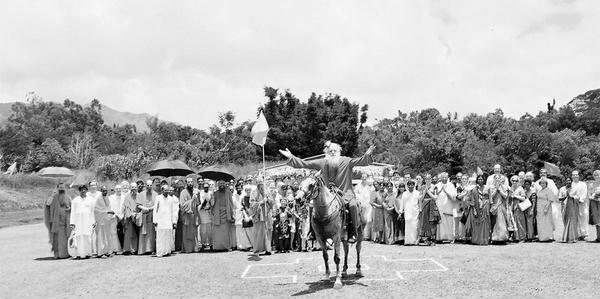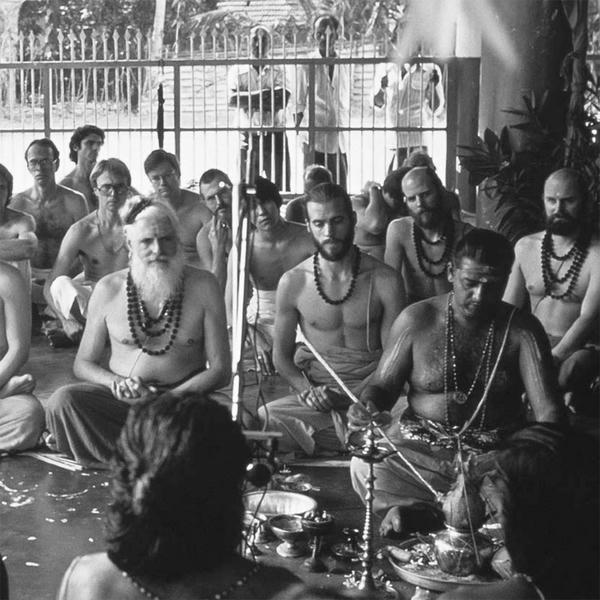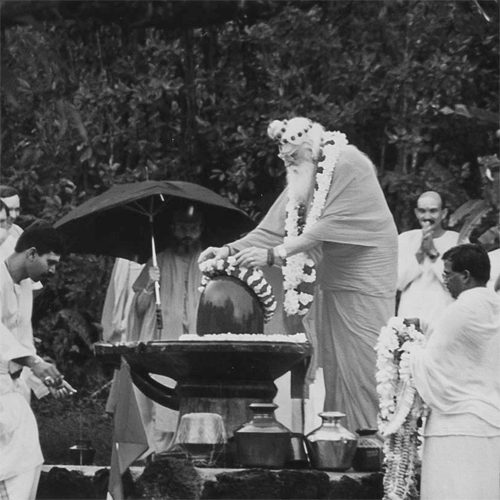Never have there been so many people living on the planet wondering, “What is the real goal, the final purpose, of life?” However, man is blinded by his ignorance and his concern with the externalities of the world. He is caught, enthralled, bound by karma. The ultimate realizations available are beyond his understanding and remain to him obscure, even intellectually. Man’s ultimate quest, the final evolutionary frontier, is within man himself. It is the Truth spoken by Vedic rishis as the Self within man, attainable through control of the mind and purification. §
It is karma that keeps us from knowing of and reaching life’s final goal, yet it is wrong to even call it a goal. It is what is known by the knower to have always existed. It is not a matter of becoming the Self, but of realizing that you never were not the Self. And what is that Self? It is Parasiva. It is God. It is That which is beyond the mind, beyond thought, feeling and emotion, beyond time, form and space. That is what all men are seeking, looking for, longing for. When karma is controlled through yoga and dharma well performed, and the energies are transmuted to their ultimate state, the Vedic Truth of life discovered by the rishis so long ago becomes obvious.§
That goal is to realize God Siva in His absolute, or transcendent, state, which when realized is your own ultimate state—timeless, formless, spaceless Truth. That Truth lies beyond the thinking mind, beyond the feeling nature, beyond action or any movement of the vrittis, the waves of the mind. Being, seeing, this Truth then gives the correct perspective, brings the external realities into perspective. They then are seen as truly unrealities, yet not discarded as such.§
This intimate experience must be experienced while in the physical body. One comes back and back again into flesh simply to realize Parasiva. Nothing more. Yet, the Self, or Parasiva, is an experience only after it has been experienced. Yet, it is not an experience at all, but the only possible nonexperience, which registers in its aftermath upon the mind of man. Prior to that, it is a goal. After realization, one thing is lost, the desire for the Self.§
Like a Child’s Self-Discovery§
Look at a child standing before a mirror for the first time, feeling its nose and ears, eyes and mouth, looking at itself reflected in the glass. Feeling and seeing what has always been there is a discovery in experience. Parasiva is the same. It is always there in each and every human being on the planet. But involvement in the externalities of material existence inhibits their turning inward. The clouding of the mirror of the mind—that reflective pond of awareness which when calm sees clearly—or the ripples of disturbance on the mind’s surface distort seeing and confuse understanding. Without a clear mirror, the child lacks the seeing of what has always been there—its own face. Parasiva is an experience that can be likened to the hand feeling and the eyes seeing one’s own face for the first time. But it is not experience of one thing discovering another, as in the discovery of one’s face. It is the Self experiencing itself. Experience, experienced and experiencer are one and the same. This is why it is only registered on the external mind in retrospect.§
Most people try to experience God through other people. Disciples see a guru as God. Wives see their husband as God. Devotees see the Deity in the temple as God. But all the time, behind the eyes of their seeing, is God. The Self, Parasiva, can be realized only when the devotee turns away from the world and enters the cave within as a way of life through initiation and under vows. We know the Self within ourself only when we fully turn into ourselves through concentration, meditation and contemplation and then sustain the resulting samadhi of Satchidananda, pure consciousness, in hopes of finding, determined to find, That which cannot be described, That which was spoken about by the rishis, Parasiva, beyond a stilled mind, Parasiva that has stopped time, transcended space and dissolved all form.§
Defining the Destination§
How can we know when we’re ready to know the Self? How do we know when the soul is spiritually mature? When we begin a journey and clearly define our destination, then we must begin from where we are, not elsewhere. Clearly defining our destination requires knowing where we are, requires determining whether or not we want to go there at this time. We must ask whether we have the means, the willpower, to get there. Are we ready to leave the world, or must we fulfill further obligations in the world and to the world? Have we paid all of our debts? We cannot leave the world with karmas still unresolved. Perhaps we desire something more, some further human fulfillment of affection, creativity, wealth, professional accomplishment, name and fame. In other words, do we still have worldly involvements and attachments? Are we ready for the final journey life has to offer? Are we prepared to endure the hardships of sadhana, to suffer the death of the ego? Or would we prefer more pleasures in the world of “I” and “mine”? It is a matter of evolution, of what stage of life we have entered in this incarnation—is it charya, kriya, yoga or jnana? When the soul is spiritually mature, we know when we’re ready to know the Self.§
When one is bound down by his past karmas, unhappy, confused and not performing with enthusiasm his dharma—be it born or chosen—making new karmas as a result, his lethargy results in despair. The camel walks slower with a heavy burden and stops if the burden is still heavier. The burdened have no sense of urgency, no expression of joy. They have stopped. They are standing on the path holding their troubles in their hands, unwilling and unable to let go.§
Worship of Lord Ganesha sets the path of dharma. Go to His Feet. He alone can perform this miracle for you. He will release the mental and emotional obstructions to spiritual progress. He will remove the burdens of worldliness. To live the perfect life of the grihastha dharma, of family life, brings as its fulfillment the all-knowing bliss of Satchidananda, realizing ourself not as formless Parasiva but as the pure consciousness that sustains and pervades all forms in the universe. Yes, there is a sense of urgency on the path of enlightenment, but only when we are unburdened of karma, only when we are walking the path of dharma. Only then can true yoga be practiced and perfected.§
All Hindus without exception believe in reincarnation. In each birth we must fulfill more goals leading to the one ultimate goal which after many births well lived will loom before us as the only goal worthy of striving for in this lifetime. All other desires, all other aims and ambitions pale under the brilliance of even the thought of realization of Satchidananda and Parasiva.§
In fulfillment of our duties to parents, relations and the community at large, become a good householder, be a good citizen, live a rewarding physical, emotional and intellectual existence. These are the natural goals of many. Once this is accomplished in a lifetime, it is easy in future lives to perpetuate this pattern and evolve toward more refined and more difficult goals, such as gaining a clear intellectual knowledge of the truths of the Agamas and Vedas, most especially the Upanishads, and establishing a personal contact with Lord Siva within His great temples through the fervor of worship.§
Harnessing the Energies§
Still other goals must be met: quieting the energies, the pranas, through pranayama, purifying or refining mind and emotion, quelling the ever-constant movement of the restless, external mind and its immediate subconscious, where memories are stored, preserved memories which give rise to fear, anger, hatred and jealousy. It is our past that colors and conditions, actually creates, the future. We purge the past in the present, and we fashion the future in the present.§
All of these emotions are the powerful force that bursts the seals of the psychic chakras, four, five, six and seven. Once harnessed, turned inward and transmuted, this life force drives the spiritual process forward. Ours is the path of not only endeavoring to awaken the higher nature, but at the same time and toward the same end dealing positively and consciously with the remnants of the lower nature, replacing charity for greed and dealing with, rather than merely suppressing, jealousy, hatred and anger.§
Most people do not understand that they have a mind, that they have a body and emotions, that what they are is something far more lasting and profound. They think they are a mind, they presume they are a body and they feel they are a given set of emotions, positive and negative. To progress on the spiritual path, they must learn they are not these things but are, in fact, a radiant, conscious soul that never dies, that can control the mind and directs the emotion toward fulfillment of dharma and resolution of karma. While living in a normal agitated state of fears, worries and doubts, seeing the deeper truths is impossible. To such a person, there is no doubt about it: “I am fearful. I am worried. I am confused. I am sick.” He says such things daily, thinking of himself in a very limited way.§
This wrong identification of who we are must be unlearned. Before we actually begin serious sadhana, we must understand ourselves better, understand the three phases of the mind: instinctive, intellectual and superconscious. This takes time, meditation and study—study that must culminate in actual experience of the instinctive mind, the intellectual mind and the transcendent subsuperconscious state of the mind. Seeing the mind in its totality convinces the seeker that he is something else, he is the witness who observes the mind and cannot, therefore, be the mind itself. Then we realize that the mind in its superconsciousness is pure. We do not have to purify it, except to carry out its native purity into life, into the intellect by obtaining right knowledge and transmuting the instinctive or animal qualities. This is accomplished from within out. It is not as difficult as it may seem.§
Preparations for True Yoga§
We must live in the now to follow the path to enlightenment. In the lower realms of the mind, where time and space seem very real, we are worried about the past or concerned about the future. These two intermingle and limit conscious awareness. Living in the past or the future obstructs us in this way: the past, by reliving old experiences—mainly the negative ones, for they are vividly remembered—clouds our vision of the future. Living in the future overactivates the intellect, the emotion and the desires. The future is little more than another form of mental fantasy. Past and future are equally unreal and a hindrance to spiritual unfoldment. A person functioning in the now is in control of his own mind. He is naturally happier, more successful. He is performing every task with his fullest attention, and the rewards are to be seen equally in the quality of his work and the radiance of his face. He cannot be bored with anything he does, however simple or mundane. Everything is interesting, challenging, fulfilling. A person living fully in the now is a content person.§
To attain even the permission to perform yoga one must have the grace of Lord Ganesha and the grace of Lord Murugan. Lord Murugan is the God of the kundalini, of the advanced yogic practices. Unfoldment all happens within the kundalini and the chakras within our subtle bodies. Once a profound relationship is developed with Lord Murugan, then, with the guru’s permission and guidance, true yoga may commence. Otherwise, no matter how long one sits in meditation, no matter how hard one tries, it is just sitting, it is just trying. There is no fire there, no shakti, no power, no change. It is the Gods who control the fire and at this stage help the devotee immensely, bringing him closer and closer to the supreme God, Siva. Quite often the yogi in his deep internalized state may see in vision the feet or form of God Siva before he begins to blend into the mind of God Siva, called Satchidananda. It is God and Gods in form that help us to find the formless God.§
The Perspective of the Knower§
Most people have not realized that they are and were Siva before they search for Siva. They are confined to their own individual anava, their personal ego and ignorance. When we realize that we have come from Siva, the way back to Siva is clearly defined. That is half the battle, to realize we came from Siva, live in Siva and are returning to Siva. Knowing only this much makes the path clear and impels us to return to Him, to our Source, to our Self. We only see opposites when our vision is limited, when we have not experienced totally. There is a point of view which resolves all contradictions and answers all questions. Yet to be experienced is yet to be understood. Once experienced and understood, the Quiet comes.§

The only change that occurs is the awakening of the sahasrara chakra and the perspective that a mind has which has undone itself, transcended itself in formless Being and Non-Being, and then returned to the experiences of form. The experiences are all still there, but never again are they binding. The fire or life energy, which rises in the normal person high enough to merely digest the food eaten, rises to the top of the enlightened man’s head, burns through a seal there, and his consciousness has gone with it. He is definitely different from an ordinary person. He died. He was reborn. He is able and capable of knowing many things without having to read books or listen to others speak their knowledge at him. His perceptions are correct, unclouded and clear. His thoughts manifest properly in all planes of consciousness—instinctive, intellectual and superconscious or spiritual. He lives now, fully present in all he does.§
The internal difference that makes a soul a jnani is that he knows who he is and who you are. He knows Truth, and he knows the lie. Another difference is that he knows his way around within the inner workings of the mind. He can travel here and there with his own 747, without extraneous external conveyances. He knows the goings-on in far-off places. He is consciously conscious of his own karma and dharma and that of others. For him there is no apartness, due to his attainment within the chakras previously described. His only gift to others, to the world, would be blessings, an outpouring of energy to all beings from the higher planes where he resides. It is the jnani, the enlightened being, who sees beyond duality and knows the oneness of all. He is the illumined one, filled with light, filled with love. He sees God everywhere, in all men. He is the one who simply is and who sees no differences. That is his difference.§
For those who have strong dedication, samadhi is near. §
Sage Patanjali, the Yoga Sutra, 1.1,21§


